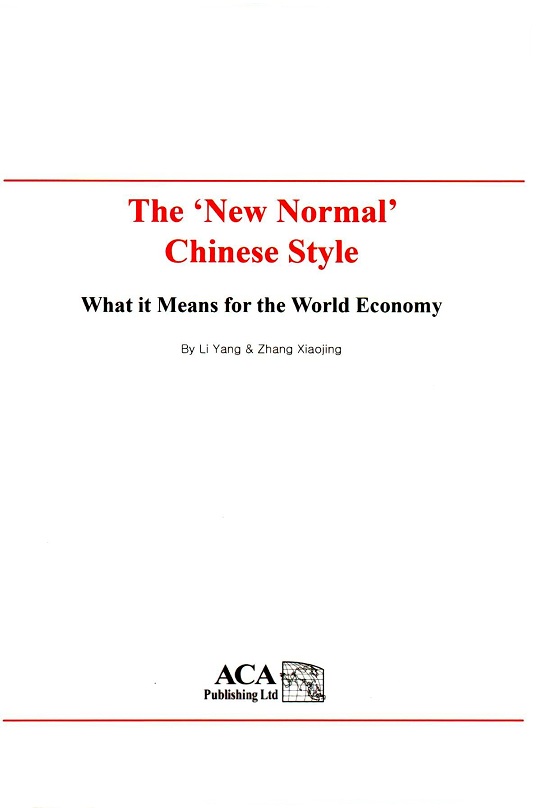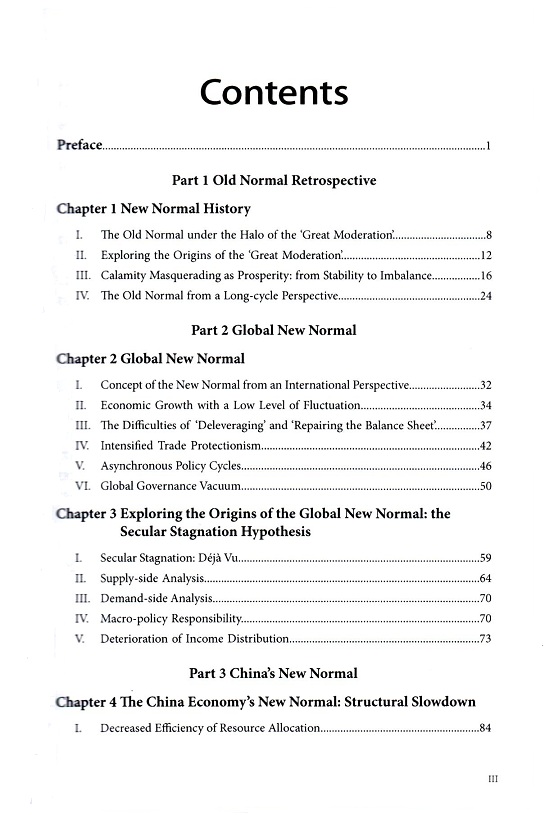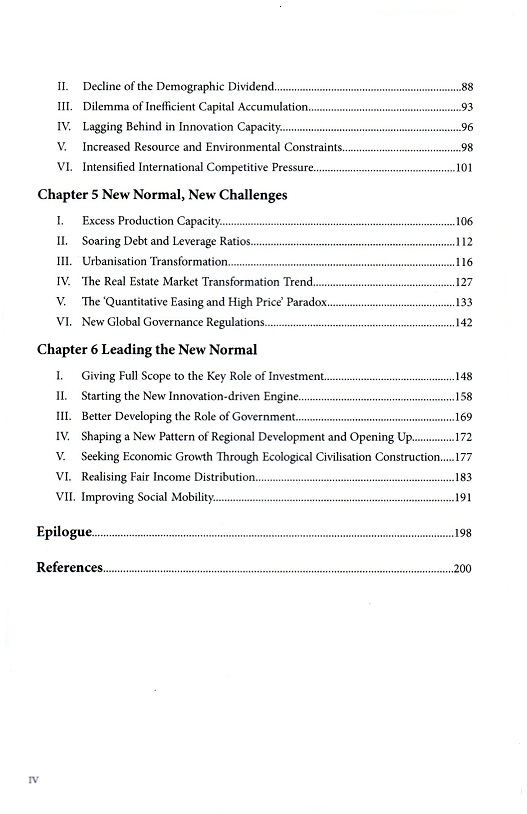订阅邮件推送
获取我们最新的更新

Preface
I
Since the start of the global financial crisis in 2008, more and more people have tended to use the phrase ‘new normal’ to describe domestic and international economic development patterns; other terms have also been used, such as ‘new phase’, ‘new era’ and ‘new order’.
However, despite its growing popularity, the term ‘new normal’ does not have exactly the same origin or meaning in different countries.
Internationally, the term ‘new normal’ was initially linked with economic recession.
In the economic context, it first appeared in Western media in 2002, when it was mainly used to refer to economic recovery without employment growth. In the wake of the global financial crisis, the term quickly applied to new global economic characteristics in the post-crisis era. In 2009, some media and renowned scholars started using the concept of ‘new normal’ in the sense of a long and in-depth adjustment after the crisis. For example, in 2010, Mohammed EL-Erian, CEO of Pacific Investment Management Company (PIMCO), the California-based investment management firm, officially proposed the concept of new normal in the sense of in-depth adjustment in the post-crisis era in a report entitled Navigating the New Normal in Industrial Countries (EL-Erian,2010). Since then, the concept has quickly spread in popularity to interpret characteristics of the world economy in the post-crisis ear. For example, Richard Clarida, a professor of economics and international affairs at Columbia University and a global strategic advisor to PIMCO (Clarida,2010) stated that, in the new normal, the economic characteristics of developed economies (high-income countries or industrialised countries) can be summarized as “low growth, high unemployment and low return on investment”.
In Chia, the term ‘new normal’ is closely linked with a new stage of the country’s economic transformation and upgrading.
In may 2014, president Xi Jinping visited Henan province. When addressing the economic situation, he said: “China’s development is still in a period with important and strategic opportunities, and we need to boost confidence, adapt to the new normal from the current features of China’s economic development and keep a common strategic mindset.” On 29 July, in a forum for non-party members held in Beijing’s Zhongnanhai, Xi Jinping again referred to the ‘new normal’ in the context of the prevailing economic situation, pointing out that: “It is necessary to correctly understand the characteristics of China’s economic development stage, further boost confidence, adapt to the new normal, and jointly promote sustained and healthy economic development.” Later that year, on 10 November, at the APEC CEO summit held in Beijing, Xi delivered a keynote speech that focused on the speed of change, structural optimization and dynamic transformation under the new normal of China’s economic development. He then expounded on the four new development opportunities in China brought about by the new normal: first, although the speed of China’s economic growth is slowing down, the actual increment is still considerable; second, China’s economic growth is becoming more stable, with more diversified growth momentum; third, China’s economic structure is being optimized and upgraded, with more stable development prospects; fourth, the Chinese government is vigorously decentralizing, giving rise to accelerated market dynamics. At a central economic work conference on 9 December 2014, the new normal was again identified as a logical starting point of China’s economic development strategy for current and future periods. In this important conference, President Xi gave a detailed analysis of China’s economy under the new normal from the perspective of consumer demand, exports and international balance of payments, production capacity and industrial organization, comparative advantages of production factors, characteristics of market competition, resource and environmental constraints, accumulation and resolution of financial risks, resource allocation model and macro-control mode. He concluded: “The entry of China’s economic development into the new normal is an inevitable reflection of its economic development characteristics at the current stage, which is not subject to change by human will. Understanding the new normal, adapting to the new normal and leading the new normal, are the great logic underpinning China’s economic development for the current and future periods.”
Obviously, the new-normal concept has been formed relatively independently at home and abroad. China’s new normal should be seen as President Xi Jinping’s expression of creative transformation: if the global new normal is regarded as a pessimistic assessment of future world economic trends, then China’s new normal contains positive elements of economic evolution towards a more advanced future, involving a more complex division of labour and a more rational structure.
II
The ‘new normal’ is a strategic concept that runs through history.
The word ‘new' divides global development since the late 1980s into two periods, each with systemic differences. In terms of external characteristics, the two periods are differentiated by high and low economic growth, and naturally also by intrinsic differences in macroeconomic variables, such as employment, prices, interest rates, exchange rates, balance of payments, fiscal revenue and expenditure, and money supply and demand. With regard to internal root causes, there are also different traits in the physical infrastructure needed to support long-term economic development, such as technological innovation and its level of industrialisation, population structure, the efficiency in the supply of key elements, the relationship between savings and investment, and the real interest rate level in the state of equilibrium between savings and investment. Therefore, the concept of new normal shows us that, in recognition of the current situation and in planning for the future, we must first settle down to review the road we have travelled, carefully analyse the ‘old normal’, and clarify where we started from a few decades ago, what is the trend of development why we cannot continue on the old track, the direction of future development and what kind of real economic base and institutional mechanisms need to be created to achieve this transition.
Determining the ‘new normal’ indicates the fundamentals needed for domestic and international economic development in current and future periods. It reminds us that the glory of the old normal may have its attractions, but that in practice it may be difficult to turn back the clock. Therefore, looking ahead, we must fully adjust our ideas, attitude, strategy and policy, to adapt positively to the new normal, learn the way of production and life under the new normal, and actively lead the new normal towards a higher development goal.
There is no doubt that the new normal contains new dynamics for development. In order to discover, exploit and make good use of the dynamics, we need to make a revolutionary adjustment to our old and trusted development way. push ahead with painful reform of the economic structure skewed by the old normal, and lead the new normal with a high degree of wisdom. This means that reform will constitute a regular task under the conditions of the new normal.
Given the fact that the new normal is a global phenomenon, it is logical to assume that the world has entered a ‘period of reform and competition' since the 2008 financial crisis. This means that those countries with the most profound understanding, the most comprehensive strategy, the most determination and the greatest commitment towards urgent, arduous and diverse reform, will seize the initiative in the future global competition. Undoubtedly, in this regard, China is once again at the forefront of the world: the determination to comprehensively deepen reform and the rule of law approved by the third and fourth plenary sessions of the 18th Central Committee of the Communist Party of China(CPC), and the central economic work conference held in 2014,have outlined for us a complete programme for carrying out a new round of reform and achieving the China dream.


Part 1
Old Normal Retrospective
In order to conduct an in-depth study of the new normal, we should first make a serious analysis of the old normal. If we do not know where we started and fail to realise the trend of development and why we can no longer continue on the old track and see where future development lies, we will not be able to understand the new normal or adapt to it, let alone lead the new normal. Before the new normal, the world experienced an old normal phase known by economists as the ‘great moderation'. The old normal involved the coexistence of sustained high growth, low inflation, low unemployment and a weakened economic cycle fluctuation. The ‘great moderation' was a comprehensive product of worldwide in-depth development of science and technology, systemic and mechanistic changes, and more intensive globalization.
2007 was a turning point in the transition from the ‘great moderation’ to the great crisis, and it occurred for three main reasons. First, after more than 20years of peace and prosperity, the widespread distortions in economic development and economic structure in countries around the world became prevalent. However, by indulging in the ‘great moderation, most countries, especially developed economies, failed to consider making adjustments for a long time. Second, the irrational global economic order and corresponding governance system after global division of labour and reorganisation have caused severe global economic imbalances, with the rise of emerging economies, especially China, having an impact on the old order. Third, the long cycle of rising global economic growth has run out of steam and begun to shift towards a period of downturn.
Following the end of the old normal, whose main characteristic was the ‘great moderation', the global economy has entered a new normal phase involving in-depth adjustment and rebalancing. The world and China are impacted, without any exception.
...
Part 2
Global New Normal
Since the 2007 US subprime crisis, the global economy has displayed some new characteristics which were initially regarded as abnormal phenomena. However, with the passage of time, it has been found that such abnormality has not disappeared as expected. Consequently, the ‘abnormal' has become ‘normal’ and there is no alternative but to accept the new normal.
The global new normal has different manifestations with five major general features, namely, a low level of fluctuation in economic growth; the economic recovery of all countries sinking into the dilemma of ‘deleveraging’ and ‘repairing the balance sheet';the prevalence of trade protectionism; the asynchronous policy cycles of major countries; and the global governance system is broken, leaving a vacuum.
The five major features of the global new normal can be summarised as a ‘secular (long-term) stagnation’ and all other summarisations are related with or derived from this. The reasons for long-term global stagnation (mainly the developed economies) are: First, are the supply-side factors, including slow technical progress, a worsening population structure and labour market, downsizing and a negative true interest rate level; second, are the demand-side factors, referring to the fact that actual growth has been lower than the long-term potential tendency for a rather long time (namely, there is a big output gap) and the so-called ‘balance sheet recession effect'; third, is the responsibility of macropolicy, that is to say, excessive dependence on demand policy is beyond control even when the policy rate is close to zero or even negative; fourth, continuously worsening income distribution further inhibits the potential growth and social vitality of the developed economies.
...
Part 3
China's New Normal
If we say that the main characteristic of the global new normal is secular stagnation, then the defining characteristic of China's new normal is structural slowdown. The main causes of structural slowdown are decreased efficiencyin resource allocation and effective supply of essential elements, the dilemma of low efficiency in capital accumulation, lagging innovation capacity, increased resource and environmental constraints, and intensified international competitive pressure.
The new normal brings new challenges. The external characteristics of the new normal involve the easing of economic growth to a medium-to-high level producing an effect on the national economy of rocks protruding as the water level drops', which will not only expose deep, multi-layered contradictions long hidden in our national economic operation, but may also lead to new conflicts. The major challenges facing us in the new normal are excess production capacity, skyrocketing debt and leverage ratios, urban transformation, the turning of the tide in the real estate market, the paradox of large quantities and high prices, and new global governance regulations.
Economic slowdown is just one of the external characteristics of the new normal. The global new normal means supply chain reorganisation, economic restructuring, a remodelling of the governance system and a realignment of relations among major powers; China's new normal means a ‘rebirth' of its economy, involving a breaking away from investment-driven and export-driven growth models, and the pursuit of quality, efficiency, innovation, ecological awareness and sustainable development, and it also means transcending the middle-income trap and striding down the road towards a great revival of the Chinese nation.
However, this glorious vision is by no means easy to attain. In order to be successful, we must lead the new normal, improve the key role of investment stimulate innovation, enhance our government, shape new patterns in regional development and opening up, seek environmentally-sustainable economic growth, achieve inclusive growth and enhance social mobility.
...
Epilogue
The top priority of China's present economic growth is to successfully make the transition from the old normal to the new normal.
In essence, the task in the transition period is to eliminate all sorts of conflict related to imbalance, incompatibility and unsustainability, and to gradually eradicate the socio-economic foundation for these conflicts by carefully implementing the decisions of the third and fourth plenary sessions of the 18h central committee of the CPC and the spirit of the central economic work conference, further deepening reforms, comprehensively promoting law-based governance, comprehensively adjusting the ideology, state of mind, strategies and policies, positively adapting to the new normal and energetically leading the new normal in its development toward securing a bright future.
In the transition from the old normal to the new normal, it is necessary to adhere to the ‘overall ideology of stable macro policy’, flexible micro policy and trustworthy social policy' and to maintain the continuity and stability of macro policy.
To maintain macroeconomic stability, it is necessary to properly handle the dialectical relationship between the potential growth rate, employment and price level in the new normal. Our analysis indicates: in the next 5 to 10 years, if China's real economic growth rate is similar to the potential growth rate (see Chapter 4), then the target of ‘two doubles'(doubling GDP and per capita income)by 2020 can be realised under the conditions of a low inflation rate. At the same time, according to CASS research on the relationship between the non-agricultural employment elasticity and labour supply in the GDP, if China's economic growth stays at about 7%,the urban employment stability can be guaranteed during 2013-2017.This means that in the next 5 to 10 years, China's macroeconomic operation can go through transformation more calmly in a relaxed environment.
During the process of carrying out the transition, macroeconomic policy should certainly pay attention to structural(oriented) control. Structural problems not only comprise a vital part of development economics but also cover the most thorny, critical, complicated and inevitably core problems of developing countries including China during their practical economic growth, which should be tackled properly. It is a new development of macroeconomic policy to start from controlling the structure of vital areas of the national economy such as industry, enterprises, the market and demand, to comprehensively implement fiscal policy, monetary policy and industrial policy, and to rectify the structural distortions of the national economy in the new situation.
The key to implementing the economic transformation is to reinforce supply management which refers to the institutional reform and corresponding policy arrangements aimed at giving impetus to corporate and market vigour, including lowering the market access threshold, reducing taxes and dues, cutting down on the cost of financing, and improving the efficiency of market factors such as labour, capital, land and resources.
It is worthwhile to learn from the experiences of developed countries relating to control on the supply side. The fundamental reasons for the ‘stagnation' of the US in the 1970s and the bubble economy of Japan soon after that were that governments universally misjudged the potential growth rate and predominantly depended on demand management policy to stimulate the economy. Furthermore, the US finally broke away from the stagnation but Japan has been unable to extricate itself from the ‘lost 20 years' crucially because the former finally transferred to controls on the supply side (the emergence of the so-called ‘supply-side revolution' and ‘Reaganomics')but Japan persisted in demand management and refused to advance with the times. In view of the similarities of China's present situation to that of the US and Japan in those years, we must conscientiously study their experiences and implement macro policy from the supply and demand sides in a bid to facilitate the economic transformation and upgrading in the new normal.

